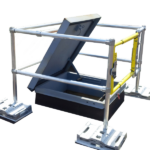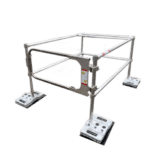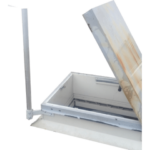Hatch Guardrail (HatchGuard)
Roof Hatch Guardrail (HatchGuard) systems are designed to provide fall protection for your roof hatch and make sure it is in compliance with working at heights laws in your province or state. Any opening in your roof that someone could fall through is required by law to have fall protection. This applies to both an open or closed hatch in many cases. It is recommended by the Ministry of Labour in Ontario to move forward with the assumption that non-structural covers (such as hatch covers) cannot support a worker unless you can provide engineering documentation confirming that they are able to support the weight of a worker who may fall or stumble on it.
What is HatchGuard?
The simplicity of HatchGuard allows for this system to be integrated with virtually all roof openings. Designed to fit on a single pallet, most parts are pre-assembled with easy-to-follow instructions and a single tool for installation. This freestanding, modular system is constructed with corrosion-resistant lightweight aluminum tubing and utilizes counter-weighted baseplates. It requires no rooftop penetration, which will help to make sure that your roof will remain intact, so you will not have to worry about any unexpected leaks occurring from using this system.
Each system is equipped with a spring loaded, self closing gate, ensuring the HatchGuard is in a safe operating position at all times.
HatchGuard has been designed to meet or exceed all major North American safety standards/regulations for hatches, including Ontario MOL requirements, ANSI, OSHA, Canadian OHS & WorkSafeBC.
4 foot by 4 foot Kit | HatchGuard
HatchGuard comes in a unique kit format which is designed to fit most rooftop hatch openings. With 4′ x 4′ of aluminum handrail tube and a 4 foot self-closing gate, you will be able to keep both employees and contractors safe when they enter and exit your rooftop.
Can be equipped with optional grab bar.

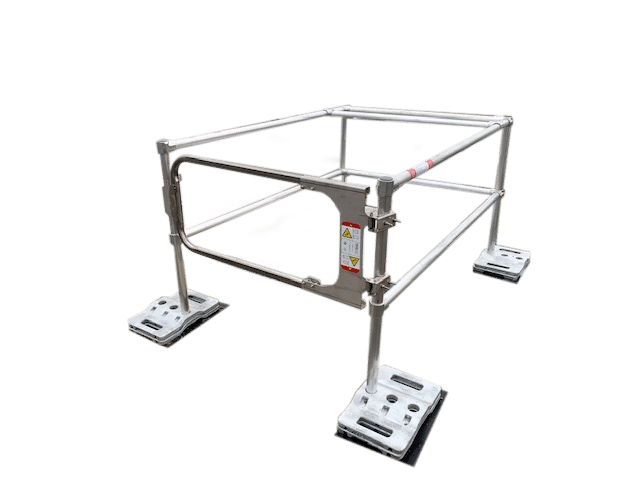
4 Foot by 6 Foot Kit | HatchGuard
Some rooftop hatches are unique in design, whether they are larger than the average rooftop hatch or because they are unique in design; which is why we offer the option for 4′ x 6′ HatchGuard systems.
Can be equipped with optional grab bar.
Grab Bar | HatchGuard
Allow your contractors and employees to safely enter and exit your rooftop hatch with the addition of a hatch bar. These roof hatch grab bars mount directly to the frame of the hatch and act as a single point of assistance. With the addition of this roof hatch grab bar, your entry onto rooftops will be both quick and safe. This accessory is designed to work on all makes and models of roof hatches and has been rigorously tested to meet stringent weight and durability requirements.
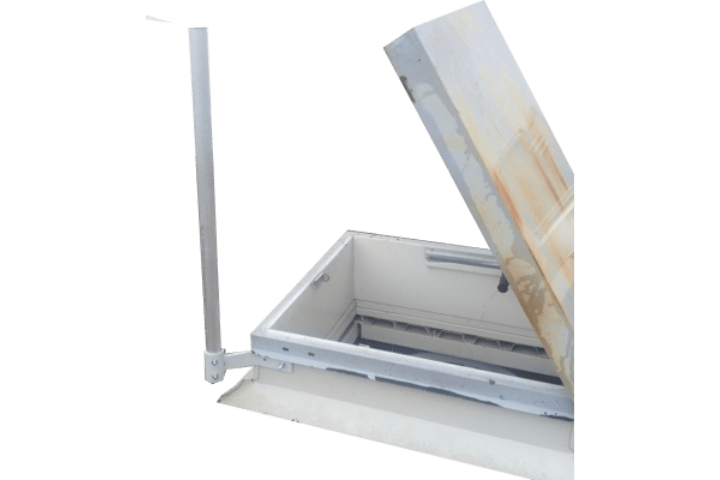
HatchGuard Specifications
| Kit Size | Part Number | Height | Coverage | Diameter of Rail | Unit Weight |
|---|---|---|---|---|---|
| 4' by 4' | HG-KIT-08 | 42" from the ground to the top of the top rail | 16 square feet of coverage | 1.9" OD Aluminum Pipe | 450 lbs. |
| 4' by 6' | HG-KIT-4x6 | 42" from the ground to the top of the top rail | 24 square feet of coverage | 1.9" OD Aluminum Pipe | 500 lbs. |
Fall Protection Regulations in Canada
| Jurisdiction | Regulation |
|---|---|
| Federal (Canada) | Canada Occupational Safety and Health Regulations, SOR/86-304, Sections 12.01 to 12.09 |
| Ontario |
|
| Quebec |
|
| Alberta | Occupational Health and Safety Code, 2009 Part 9, Fall Protection Sections 138 - 161 |
| British Columbia | Occupational Health and Safety Regulations, B.C. Reg. 296/97 Part 11, Fall Protection, Sections 11.1 to 11.10 |
| Manitoba | Workplace Safety and Health Regulation, Man. Reg. 217/2006 Part 14, Fall Protection, Sections 14.1 to 14.23 |
| New Brunswick | General Regulation -N.B. Reg. 91-191 Part VII, Protective Equipment, Sections 49 - 51 |
| Newfoundland and Labrador | Occupational Health and Safety Regulations, 2012, N.L.R. 5/12 Part X, Fall Protection, Sections 138 to 146 |
| Nova Scotia | Workplace Health and Safety Regulations, N.S. Reg. 52/2013 Part 21, Fall Protection, Sections 21.1 to 21.4 |
| Prince Edward Island | Fall Protection Regulations, EC2004-633 |
| Saskatchewan | Occupational Health and Safety Regulations, 1996, R.R.S., C. O-1.1, R. 1 Sections 102 to 107, and Sections 116 to 116.3 |
| Northwest Territories |
|
| Nunavut | General Safety Regulations, R.R.N.W.T. 1990, c. S-1, Part 7 Sections 104 to 109, and Part 9, Sections 118 to 122 |
| Yukon |
|
Resources
Roof Access Ladder Legislation in Canada
An article that breaks down the legislation regarding roof access ladders.
Working at Heights Legislation in Canada
An article that breaks down the existing legislation and different solutions offered.
HatchGuard Standard Kits for local school
Case Study for HatchGuard as a solution for a roof hatch at a local school.
Your Perfect Solution Awaits!
Frequently Asked Questions
At what height is Fall Protection required?
Employers must provide protection to prevent employees from falling. According to Canadian Centre for Occupational Health and Safety (CCOHS) laws, any surface 3 metres (10 feet) above another level requires fall protection. In most cases, fall protection is required when:
- other means of fall protection are not available or possible, such as guardrails
- working at a height of 3 metres or more (permanent and/or temporary work areas)
- working at a height of less than 3 metres when the surface below could cause a greater injury than just the fall (e.g., machinery; risk of drowning in water or other liquid; open tanks, vats, or pits containing hazardous materials; materials that can shift)
- a worker may fall through an opening in the work surface
- it is determined that fall protection is necessary
I don’t know if I need a HatchGuard system. Can Liftsafe Fall Protection help me decide?
For sure! Fall protection regulations can be tricky, so if you’re unsure whether a HatchGuard system is the right solution, we can help. Just click here to fill out the form with as much detail as possible and our team will get back to you as soon as possible for a complete consultation. You can also reach our team directly at:
Phone: 1-800-977-2005
Email: info@liftsafegroup.com
Do HatchGuard Systems comply with current US/Canada safety regulations?
What is the difference between active and passive fall protection?
Both active and passive fall protection are effective in protecting workers from falling. However, while active protection requires involvement from the worker, passive systems can keep people safe regardless of training level and awareness of a hazard.
Active fall protection are known as Personal Fall Arrest Systems (PFAS), such as body harnesses, lanyards, and anchor points. Passive fall protection, alternatively, are physical barriers or systems, such as guardrails and safety nets, that prevent workers from falling or catch them if they do fall.
Passive solutions are always preferred to active ones. They represent engineering controls that keep people safe regardless of training level and awareness of a hazard.
How can I purchase HatchGuard from Liftsafe Fall Protection?
It’s pretty simple. Click here to request a quote and our team will get back to you as soon as possible. Don’t forget to fill out the form with as much detail as possible so we can provide a precise quote. You can also reach our team directly at:
Phone: 1-800-977-2005
Email: info@liftsafegroup.com
How long does it take to install a HatchGuard? Does it require any special tools or skills?
HatchGuard is incredibly simple to install and can be easily installed by an inexperienced worker with simple hand tools and our instructions. Each system has labels that contain a QR code linking to a series of videos showing exactly how to install it for maximum time savings.
Are HatchGuard Systems certified by an engineer?
Each HatchGuard system comes with a stamped engineering drawing back by the in-house engineering team at Liftsafe Fall Protection.
If I close my lid, do I need HatchGuard?
Yes. For two main reasons:
- When the lid is open, you are non-compliant;
- It is recommended by the Ministry of Labour in Ontario to move forward with the assumption that non-structural covers (such as hatch covers) cannot support a worker unless you can provide engineering documentation confirming that they are able to support the weight of a worker who may fall or stumble on it. This also applies to skylights.
Only three sides are protected by a railing, does the gate leave my hatch unprotected?
No. HatchGuard comes with a spring loaded, self closing gate that swings shut automatically as soon as the user walks through it. The gate itself acts as the fourth side of the HatchGuard system.
Does HatchGuard mount to the hatch?
No. The HatchGuard system is freestanding and independent of the hatch it is protecting. This provides a number of advantages such as creating a safe zone when exiting a hatch (particularly when close to a roof edge). Also, mounted systems can be difficult to install properly and may not fit the hatch it is mounting to if there isn’t enough clearance.
Because it is a modular system, it can also be combined with RoofGuard Classic systems and RoofWalk in order to create egress and walkways for maximum protection.
Does a ladder up bar protect my hatch?
No. Ladder up bars still leave an opening that someone can fall through. We recommend using a larger HatchGuard when you have these, as they can be difficult to operate while maintaining three points of contact on your ladder if the railings are too tight to the hatch. This is mainly a problem that you run into with mounted systems.
How do I know what size I should use?
In our experience, it is better to add some extra space for egress when installing HatchGuard. Our fall protection specialists can work with your team to decide on the best configuration based on your situation.
Are guardrails more expensive than horizontal lifeline systems?
While every system is different, at times the initial costs of guardrail can be slightly more compared to horizontal lifeline systems. However, you also need to consider the costs of certifying employees for working at heights (every three years), anchor point inspections (annually), lanyard and harness costs and inspections (annually), recordkeeping (ongoing), a rescue plan, and other related costs. When you take these into account, the overall cost of an installed guardrail system is much lower when compared to horizontal lifeline systems.
There is also the amount of time and resources that must be devoted to making sure these are all adhered to. Whereas, a guardrail system can be set up once and you are instantly compliant.
Are the materials used in the HatchGuard Systems protected from corrosion and other environmental factors?
Yes. HatchGuard Systems are typically made of aluminum, which ensure durability in diverse weather conditions. They are designed to be protected from corrosion, rust and other environmental factors, and its components contribute to resistance to environmental wear and tear.
Can HatchGuard be painted?
Yes. HatchGuard comes standard as an aluminum system that is grey but some clients prefer it to be painted safety yellow. This is done in-house with a powder coated paint that is weather resistant.
Can HatchGuard be used as an anchor?
No. HatchGuard must not be used as an anchor. This is stated explicitly in the RoofGuard installation manual among other safety requirements.
Integrated RoofWalk and RoofGuard System Case Study
Combining RoofWalk and RoofGuard Classic on a sloped steel roof.
Become a
RoofGuard Dealer
Custom rooftop solutions backed by our in-house team of Professional Engineers. Offer your clients a simple to install fall protection solution that requires no extra training or equipment.
Fall Protection Guide
Check to see what federal & provincial regulations for working at heights and fall protection are and which RoofGuard systems help you comply.
Customer Service
Resources
Learn from the experts about safety topics related to working at heights, warehouse safety and ladder safety. Browse our resource library.
Liftsafe Fall Protection
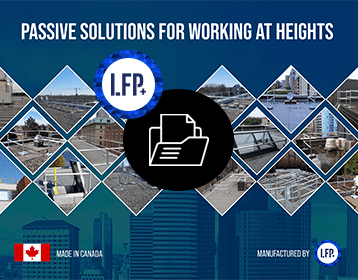
Catalogue
Details about all of our RoofGuard systems can be found in our Liftsafe Fall Protection Catalogue along with safety statistics and other info.
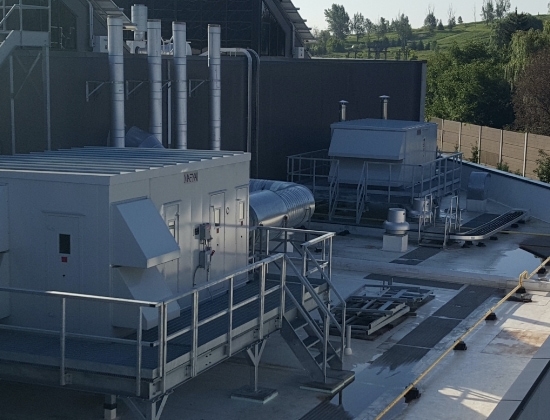
Liftsafe Fall Protection
Supplier of Working at Heights Protection, Aviation Access Products, Netting Safety Systems and Engineering Services across Canada.

About Liftsafe
We focus on creating turnkey solutions that allow your employees to do their jobs safely while protecting your company.

